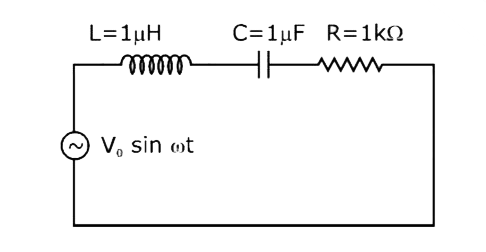In the figure shows R=100Ω,L=2πH and C=8πμF are connected in series with an a.c. source of 200 volt and frequency f. V1 and V2 are two hot-wire voltmeters. If the reading of V1 and V2 are same, then

f=125Hz
f=250πHz
Current through R is 2A
V1=V2=1000 volt
The correct Answer is:A, C, D
V1=V2⇒xL=xC
⇒f=12π√LC=125Hz
I0=v0R=200100(∵x=0,∴z=R)
V1=V2=IXL=I.(ωL)=IL.1√LC=I√LC=2
⎷(2/π)(8×10−6/π)=1000 volt
Topper's Solved these Questions
- TEST PAPERSBOOK - FIITJEECHAPTER - TEST PAPERSEXERCISE - PHYSICS
747 Videos
- SIMPLE HARMONIC MOTIONBOOK - FIITJEECHAPTER - SIMPLE HARMONIC MOTIONEXERCISE - Assignment Problems (Objective) (Level-II)
20 Videos
- WORK, ENERGY AND POWER BOOK - FIITJEECHAPTER - WORK, ENERGY AND POWER EXERCISE - COMPREHENSIONS ( Comprehension-II)
5 Videos
Similar Questions
In the figure shown R=100Ω, L=2πH and C=8πμF are connected in series with a.c source of 200 volt and frequency 'f'. V1 and V2 are two hot-wire voltmeters. If the readings of V1 and V2 are same then:

View SolutionIn the figure shown R=100ΩL=2πH and C=8πμF are connected in series with a.c source of 200 volt and frequency 'f'. V1 and V2 are two hot-wire voltmeters. If the readings of V1 and V2 are same then:

View Solution
Knowledge Check
In the figure shown R=100ΩL=2πH and C=8πμF are connected in series with a.c source of 200 volt and frequency 'f'. V1 and V2 are two hot-wire voltmeters. If the readings of V1 and V2 are same then:
 Af=125HzBf=250HzCCurrent through R is 2ADV1=V2=1000 volt
Af=125HzBf=250HzCCurrent through R is 2ADV1=V2=1000 voltIn the circuit shown, L=1μH,C=1μF and R=1kΩ. They are connected in series with an a.c. source V=V0sinωt as shown. Which of the following options is/are correct?
 AThe current will be in phase with the voltage if ω=104rad.s–1BAt ω>>106rad.s–1, the circuit behaves like a capacitorCThe frequency at which the current will be in phase with the voltage is independent of RDAt ω≅0 the current flowing through the circuit becomes nearly zero.
AThe current will be in phase with the voltage if ω=104rad.s–1BAt ω>>106rad.s–1, the circuit behaves like a capacitorCThe frequency at which the current will be in phase with the voltage is independent of RDAt ω≅0 the current flowing through the circuit becomes nearly zero.The diagram shows a capacitor C and a resistor R connected in series to an AC source. V1 and V2 are voltmeters and A is ammeter

Now, consider the following statements :
(I) Reading in A and V2 are always in phase.
(II) Reading in V1 is ahead in phase with reading in V2,
(III) Reading in A and V1 are always in phase. Which of these statements are/is correctAI onlyBII onlyCI and II onlyDII and III only
The diagram shows a capacitor C and a resistor R connected in series to an AC source. V1 and V2 are voltmeters and A is ammeter

Now, consider the following statemensts :
(I) Reading in A and V2 are always in phase.
(II) Reading in V1 is ahead in phase with reading in V2,
(III) Reading in A and V1 are always in phase. Which of these statements are/is correct
View SolutionIn an LCR series ac circuit the voltage across L,C and R are V1,V2 and V3 respectively The voltage of the source is .
View SolutionIn the circuit shown in the figure, two resistors R1andR2 have been connected in series to an ideal cell. When a voltmeter is connected across R1 its reading is V1=4.0 volt and when the same voltmeter is connected across R2 its reading is V2=6.0 volt. The reading of the voltmeter when it is connected across the cell is V3=12.0 volt. Find the actual across R1 in the circuit.

View SolutionIn an LCR series ac circuit the voltage across L,C and R are V1,V2 and V3 respectively The voltage of the source is .
View Solution200 Ω resistance and 1H inductance are connected in series with an A.C. circuit. The frequency of the source is 2002π Hz. Then phase difference in between V and I will be-
View Solution
